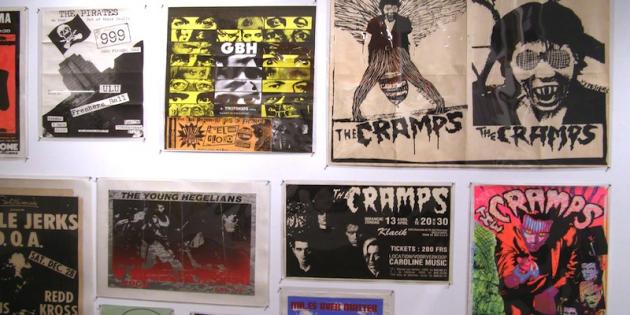A new survey exhibition exploring the extraordinary diversity of punk and post-punk graphic design has been announced for The Galleries at Moore College of Art & Design in Philadelphia. ‘Pretty Vacant’: The Graphic Language of Punk features several hundred posters, flyers, fanzines, handbills, record sleeves, badges and other graphic materials from the collection of Andrew Krivine.
Emerging in the mid-1970s, punk was truly popular culture on the margins, with new ideas germinating out of a sense of urgency and seemingly random aesthetic collisions. Before it became commercially commodified into a simplified mishmash of safety pins, mohawks and anarchy symbols, punk was as much about its wide range of visual signifiers at it was a kind of music. A do-it-yourself approach and a loathing of commercial slickness were key hallmarks of the punk attitude, informing not just the music, but also the explosion of graphic design that accompanied it. Taking cues from a wealth of influences ranging from Dadaism to the Situationist International to pulp fiction, and communicating the themes of nihilism, black humor and reappropriation, the visual language of punk was a pastiche of imagery that reflected the consciousness and anti-aesthetic of a new counterculture.
Featuring several hundred works on loan from New York-based collector Andrew Krivine, the exhibition includes iconic works by some of the most illustrious graphic artists of the period, including Barney Bubbles, Malcolm Garrett, Raymond Pettibon, Jamie Reid, Peter Saville, Linder Sterling, Gee Vaucher and Arturo Vega, as well as pieces created by the hands of talented, yet anonymous, artists. Beyond the ‘holy trinity’ of punk – The Clash, The Ramones, and the Sex Pistols – Pretty Vacant includes posters, flyers, handbills, record sleeves, badges and other graphic materials created for both iconic and obscure punk and post-punk bands, including: A Certain Ratio, The Adverts, The B-52s, Bauhaus, Blondie, the Buzzcocks, the Circle Jerks, The Cramps, The Cure, the Damned, Devo, Elvis Costello, The Fall, Fear, Gang of Four, Generation X, The Gun Club, Iggy Pop, The Jam, Joy Division, Killing Joke, Kraftwerk, Lou Reed, New Order, Public Image Limited, Sham 69, Siouxsie & the Banshees, Teenage Jesus & the Jerks, Television and X-Ray Spex.
The exhibition is on view January 25 – March 15, 2014. Emerging in the mid-1970s, punk was truly popular culture on the margins, with new ideas germinating out of a sense of urgency and seemingly random aesthetic collisions. Before it became commercially commodified into a simplified mishmash of safety pins, mohawks and anarchy symbols, punk was as much about its wide range of visual signifiers at it was a kind of music. A do-it-yourself approach and a loathing of commercial slickness were key hallmarks of the punk attitude, informing not just the music, but also the explosion of graphic design that accompanied it.

